Referência:
1. Dados da HOYA arquivados. HOYA Medical Singapore, 2020.
2. Tandogan, T. et al. (2021): In-vitro glistening formation in six different foldable hydrophobic intraocular lenses. In BMC Ophthalmol 21, 126.
3. Dados da HOYA arquivados. DoF-CTM-21-002, HOYA Medical Singapura Pte. Ltd, 2021
4. Pérez-Merino, P.; Marcos, S. (2018): Effect of intraocular lens decentration on image quality tested in a custom model eye. In: Journal of cataract and refractive surgery 44 (7), p. 889–896.
5. Leydolt, C. et al. (2020): Posterior capsule opacification with two hydrophobic acrylic intraocular lenses: 3-year results of a randomized trial. In: American journal of ophthalmology 217 (9), p. 224-231.
6. Giacinto, C. et al. (2019): Surface properties of commercially available hydrophobic acrylic intraocular lenses: Comparative study. Em: Journal of cataract and refractive surgery 45 (9), p. 1330–1334.
7. Werner, L. et al. (2019): Evaluation of clarity characteristics in a new hydrophobic acrylic IOL in comparison to commercially available IOLs. Em: Journal of cataract and refractive surgery 45 (10), p. 1490–1497.
8. Matsushima, H. et al. (2006): Active oxygen processing for acrylic intraocular lenses to prevent posterior capsule opacification. Em: Journal of cataract and refractive surgery 32 (6), p. 1035–1040.
9. Farukhi, A. et al. (2015): Evaluation of uveal and capsule biocompatibility of a single-piece hydrophobic acrylic intraocular lens with ultraviolet-ozone treatment on the posterior surface. Em: Journal of cataract and refractive surgery 41 (5), p. 1081–1087.
10. Eldred, J. et al. (2019): An In Vitro Human Lens Capsular Bag Model Adopting a Graded Culture Regime to Assess Putative Impact of IOLs on PCO Formation. Em: Investigative ophthalmology & visual science 60 (1), p. 113–122.
11. Nanavaty, M. et al. (2019): Edge profile of commercially available square-edged intraocular lenses: Part 2. Em: Journal of cataract and refractive surgery 45 (6), p. 847–853.
12. Schartmuller, D et al. (2019): True rotational stability of a single-piece hydrophobic intraocular lens. Em: The British journal of ophthalmology 103 (2), p. 186–190.
13. Miyata, A. et al. (2001): Clinical and experimental observation of glistening in acrylic intraocular lenses. Em: Japanese journal of ophthalmology 45 (6), p. 564–569.
14. Dados da HOYA arquivados. DoF-SERT-102-MULT-03052018, HOYA Medical Singapura Pte. Ltd, 2018
15. HOYA (2022): Vivinex Gemetric Testiminial Video R. Khoramnia, Arquivo de Vídeo, 2022_05_31_05_HSOE_XY1-G_XY1- GP_XY1-GT_XY1-GPT_VD_EN_RKhoramnia
16. Abulafia, A. et al. (2016): New regression formula for toric intraocular lens calculations. Em: Journal of cataract and refractive surgery 42 (5), p. 663–671.
17. Com base em uma média de olhos humanos pseudofácicos.
